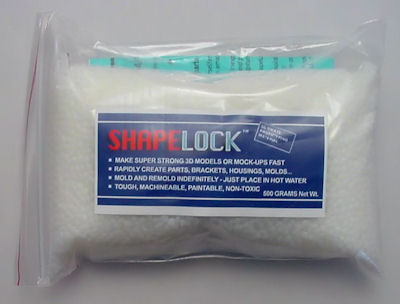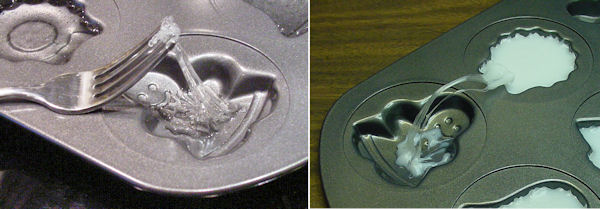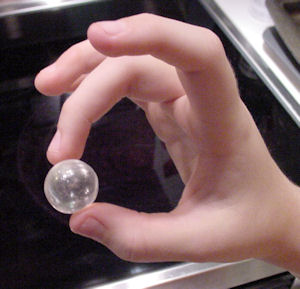For prototyping precision pieces, I’m a big fan of machining parts on a miniature lathe or milling machine. However, many hobbyists lack the means or desire to fabricate their own shapes in a machine shop. Material science comes to the rescue with a thermoplastic that melts at only 150 degrees Fahrenheit (66 degrees Celsius). That means this plastic will melt in a bowl of hot water!
Polycaprolactone (PCL) is na ultra-high molecular weight (UHMW) non-toxic polyester thermoplastic that can be formed by hand when molten. It creates a rigid, solid part when cool, similar to the plastic material used in kitchen cutting boards. The part can be reheated and adjusted or completely re-melted (along with any scraps) to be reused for entirely new creations. This low-temperature melting plastic is available by trade names ShapeLock (or Shape Lock), Friendly Plastic, and Polymorph.

ShapeLock prototyping plastic 500 gram bag.
I purchased a 500 gram (1.1 pound) bag of ShapeLock directly from their website for $25. They have a sample 35 gram bag available for only $5.

ShapeLock plastic beads or granules.
For ease of use, the plastic is supplied in small white granules, which is a common form provided by manufacturers of all types of plastics. You can pour exactly the amount you need.
The downside for a hobbyist is that the air spaces between the granules can trap air bubbles. Professional part producers use vibration, pressure, and vacuums to draw out air in the molding and forming process.
Besides white, Friendly Plastic offers a wide variety of colors in the form of sheets or sticks. Also, a number of people have posted instructions on adding paints, dyes, or other colors to produce whatever color you can image.
WARNING! This article describes an activity that involves a likely risk of getting burned. Follow the manufacturer’s instructions and only allow minors to work with adult supervision.
There are a number of techniques to heat the plastic:
My concern about the first three techniques is that you have less control over the temperature. You can scald yourself with boiling water.
The hot air gun might be a useful trick to smoothing a surface or performing minor alterations or tweaks to a finished model. But, it isn’t going to evenly heat a thick piece of material. Like most plastics, this does not conduct heat well. However, that characteristic of low thermal transfer is nice when you’re forming the molten plastic in your hands.
I suspect that an electric griddle (with a silicone baking sheet) would provide the best experience, since you can control the temperature and have convenient, direct access to the material. Melt it, shape it, set it down when it cools too much, and then pick it up to refine the shape when it starts to soften again.
Since I don’t own an electric griddle, I decided to heat my samples inside of an oven.
Wilton silicone bakeware 12 cup muffin pan.
From previous experiments, I have learned a valuable lesson about what pots and pans I can safely use in my wife’s kitchen: none of them. To spare herself the loss of a trusted tool, she was kind enough to purchase two different Wilton brand baking pans for my usage. The first is a 12-cup silicone muffin pan. The second is a “non-stick” 12-cavity cookie pan.
The melted ShapeLock plastic bonds to other plastics and some other materials. As later tests will show, it doesn’t bond to any of the bare, clean metals that I tried.

Oh no! ShapeLock bonds to non-stick cookie mold.
I was really, really surprised that it bonded with the non-stick cookie mold tray. Because the melted plastic has a consistency somewhere between hot glue, cold honey, molasses, and putty, it doesn’t come off easily from anything to which it has chemically bonded. In this case, even after attempts at higher temperatures and hot-to-freezing cold shocks, I could not successfully remove all of the melted plastic. The cookie sheet is ruined.
Update: After a year of sitting in my basement, all but one piece of plastic popped off with a little bit of effort. The final piece required the pan to be frozen again before it could be removed. Perhaps the key is to freeze the pan and then bring it to room temperature multiple times, as opposed to getting the pan hot.
Let this be a lesson to you: only use this plastic with materials that you’ve tested or pans/utensils that you don’t care if you damage them.
In contrast, the silicone muffin pan worked really well for me. Not only did the plastic not stick to it, but the flexible silicone makes it easy to pop out any leftover remnants.
I began by completely filling a muffin cup with plastic beads, setting the oven to its lowest temperature (170°, surprisingly), and placing the silicone tray on the lowest rack. Oscar, the dog, stood guard in the kitchen.

Oscar guards the kitchen.
I gave up after 15 minutes of apparently no progress in melting. Oscar, being a Border Collie, is trained to patiently look after his flock. So, he was moderately disgusted when I accelerated the melting by spreading out the plastic beads to have thinner patties, cranked the heat to 190°, and moved the tray to the top rack of the oven.
The dog finally left because he couldn’t stand my repeated opening of the oven door to check on progress, letting out most of the hot air. “Use an oven stone to retain the heat if you’re going to keep doing that!” he barked as he walked out of the kitchen.
ShapeLock beads turning transparent in a heated silicone cupcake tray.
The first sign of progress that you'll see is that the outer beads turn from white to transparent. In a short time, the entire blob turns clear and melts together.

Molten ShapeLock plastic ball is transparent.
To avoid harm, I gingerly removed a small chunk from the oven, being ready to throw it in a metal pan with luke-warm water if it ended up being too hot to handle. It turns out that plastic melted using the correct temperature is painless to handle -- and fun, too!
After an hour of playing with various chunks, the tips of my fingers felt a little tender, but the discomfort passed after stopping the activity. That being said, if you overheat the material, I can think of nothing worse than having a molten glob stuck to your burning flesh. The manufacturer’s process is safe and relatively speedy, there’s no valid reason to use dangerous temperatures.
When removed from the oven, the plastic is clear and pliable. It feels like warm clay. You can snap of chunks with your fingers, and blend it with other softened pieces. Overall, the plastic is a nice balance of being moldable and flexible without dripping. Working time is about 20 seconds (depending on the size of the piece) before more heat needs to be applied.
Let’s see some results...